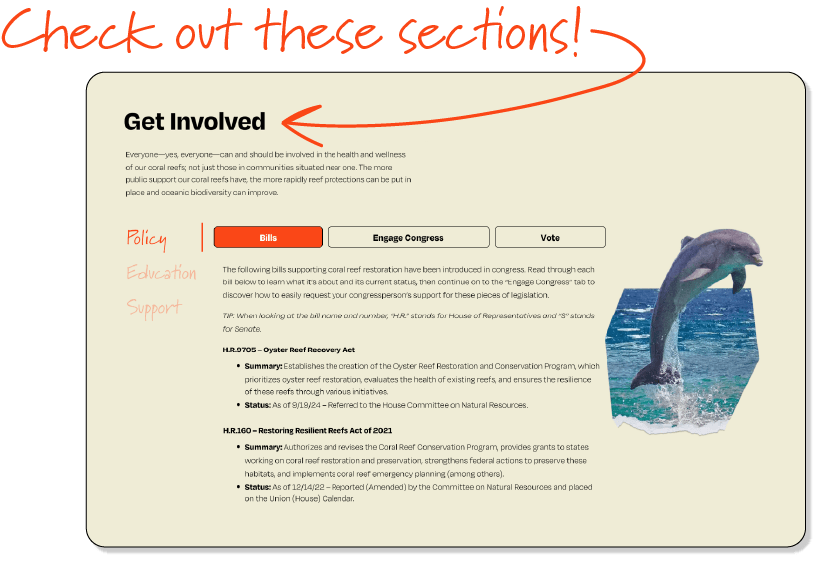SOLUTION
Coral Reef Restoration
Advancing 30×30 goals by restoring our coral reefs
Created in partnership with
Coral Restoration Foundation™
What is coral reef restoration?
Coral reef restoration, a key component of healthy oceans, encompasses methods and techniques to regrow and repair damaged coral reef systems that are under threat from pollution, overfishing, climate change, and other factors.
“[A]ll of the world’s tropical coral reefs need help. It is an ecological and humanitarian crisis as an increasing number of families who depend on coral reefs for their livelihood are imperiled.”

Traditional Indigenous Knowledge
Native Hawaiians have relied on and supported coral reef ecosystems for thousands of years. These systems are richly tied to Hawaiian culture and maintain the vast biodiversity of the Hawaiian islands. The traditional land management practice ahupua‘a speaks to the interconnectedness of all systems, from ridge to reef.2“Linking land and sea to inform ahupua‘a management,” Economic Research Organization, Univ. of Hawai’i ≫ This knowledge continues to be used to design systems of agriculture and aquaculture that benefit one another. As water flows down from the mountains, it passes through taro fields, farmed using a traditional technique called lo‘i kalo, and then continues down into fishponds which eventually let out to the coral reefs, lending nutrients along the way.3“Native Hawaiians Turn to Ancient Traditions to Save Their Reefs,” Gizmodo ≫ (IMAGE: Native Hawaiian taro farmer Jerry Konanui; Scot Nelson/Flickr)
Coral Reefs and Climate Change
The first coral reef mass bleaching events took place in the 1980s and 1990s, though scientists estimate we’ve been losing coral reefs due to human-associated activity since at least the 1950s. Experts in the field believe this to be a conservative estimate; it’s quite possible we’ve been seriously damaging our coral reefs for much, much longer.
The burning of fossil fuels is leading to warming waters and ocean acidification—both of which cause serious harm to coral populations. As a result, the world has already lost 30% to 50% of all coral reef habitats. Scientists estimate the remaining coral reef systems will go extinct by the end of the 21st century if we do not take immediate action.4“Coral Reefs Could Be Gone in 30 Years,” National Geographic ≫
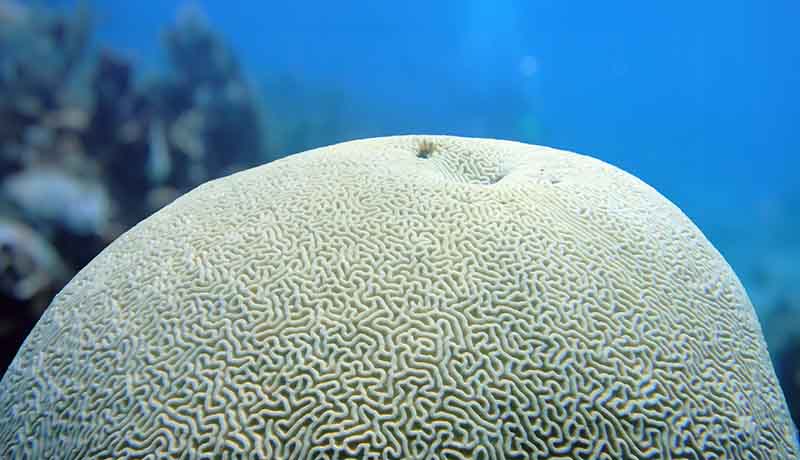
Bleached brain coral in Key Largo, Florida (IMAGE: Matt Kieffer/Flickr)
Coral Reefs and 30x30
Despite only accounting for approximately 1% of the ocean’s total area, coral reefs support 25% of all ocean life, making them a critical component of marine health. Many corals and sponges are filter feeders, keeping the waters close to shore clean as well as being home to many oxygen-producing plants and organisms.5“Coral Reef Restoration,” MOTE Marine Laboratory and Aquarium ≫
And that’s not all—our coral reefs are important for land conservation, too. Coral reefs help prevent coastal erosion by dissipating as much as 97% of a wave’s energy before it reaches the shore. This helps keep sand and sediment in place and protects nearby waterfront infrastructure from damage.6“Coastal Protection,” Coral Reef Alliance ≫
If we’re going to preserve 30% of our ecologically important marine waters as part of the 30×30 target, the health and wellness of our coral reef systems—a critical component of ocean biodiversity, water, and land health—must be addressed.
Coral Reef Restoration: The Low Down
Learn about the who, where, and when of leveraging coral reefs for 30×30 goals.
- The Who
- The Where
- The When
Most of the harms our coral reefs experience stem from climate change. To sufficiently address these concerns, we must put pressure on groups with the power to implement immediate and drastic change—governments at all levels (municipal, state, national and international) that influence policy as well as major corporations that are some of the world’s largest polluters.
To date, very limited (if any) action in support of coral reef restoration has come from these two sectors. Rather, it’s local communities and grassroots organizations who are leading the charge for coral restoration.
So, how do these responsibilities break down?
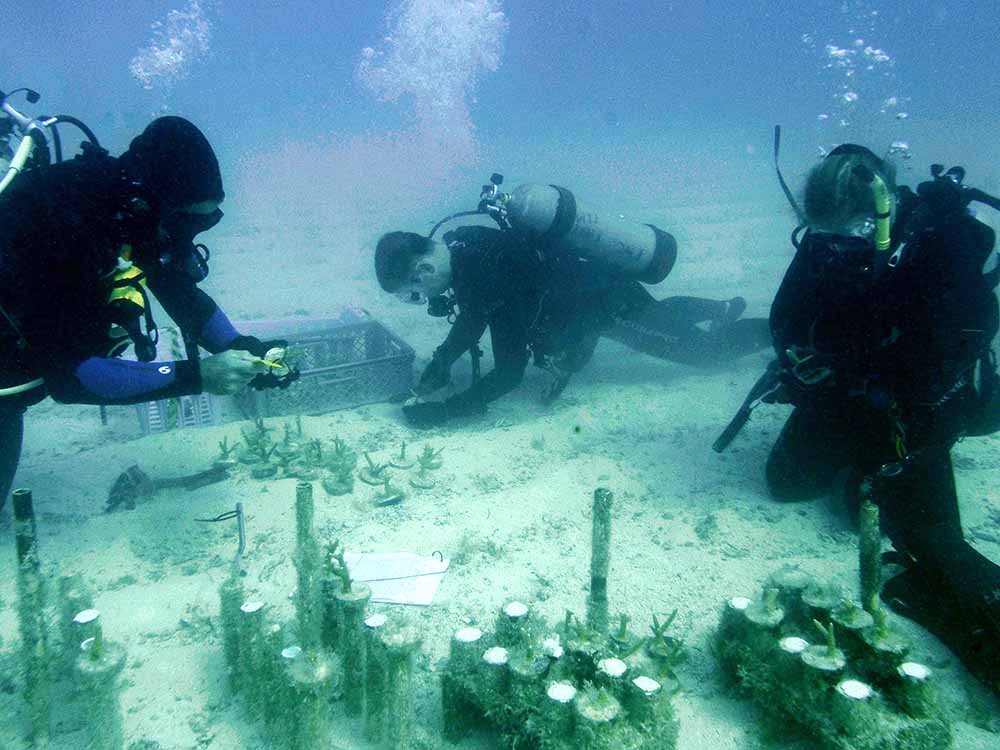
Researchers select corals from nurseries for reef restoration. (IMAGE: Florida Fish and Wildlife Conservation Commission)
A multi-pronged approach can be applied to how we address coral reef restoration with actions taking place simultaneously at local, national, and global levels. These actions will take effect largely in the lands, waters, and communities surrounding a coral reef ecosystem, but they can expand far beyond these immediate geographical regions.
Global: Reducing Fossil Fuel Usage
We need to reduce fossil fuel usage and the pollution it creates. These fossil fuel pollutants are contributing causes of climate change and reducing their inputs into maritime ecosystems will positively benefit the health of our oceans.
These efforts have a two-fold effect: lowering ocean acidification and reducing the rise of global temperatures which leads to warming ocean waters. Countries worldwide need to prioritize fossil fuel and pollution reduction through policies and regulations as soon as possible in order to curb climate change.
National: Marine Protected Areas
More than 100 countries, including the U.S, have coral reefs within their boundaries. In established marine protected areas (MPAs), governments, scientists, and organizations can better monitor these ecosystems and their coral reefs, while limiting detrimental human interaction (from divers to boats).7“Where Are Coral Reefs Located?” Coral Reef Alliance ≫; “U.S. Coral Reefs,” U.S. Environmental Protection Agency ≫
Local: Regrowing Reefs and Limiting Human Interaction
We need to protect existing coral reefs and re-establish new reef systems where others have died. This includes expanding coral nurseries; testing acidification and oxygen levels; removing invasive species; and significantly monitoring reef-based tourism. Reefs are incredibly sensitive ecosystems. Human touch can spreads toxins that impact the health of the coral and the life it supports.8“Hands to Yourself Keep: Wildlife Safe and Healthy,” National Marine Sanctuaries ≫
Coral reef restoration projects are happening right now all over the world, which is great, but these activities need to be scaled up if we’re going to achieve our 2030 conservation goals. This means projects need broader public support, prioritization by local governments and communities who rely on coral reefs for social, cultural, and economic purposes (e.g., tourism), more significant financial support, and faster implementation to prevent further coral population loss.
We realize that’s a lot to achieve in a tight timeline, so where should we begin to have the greatest impact?
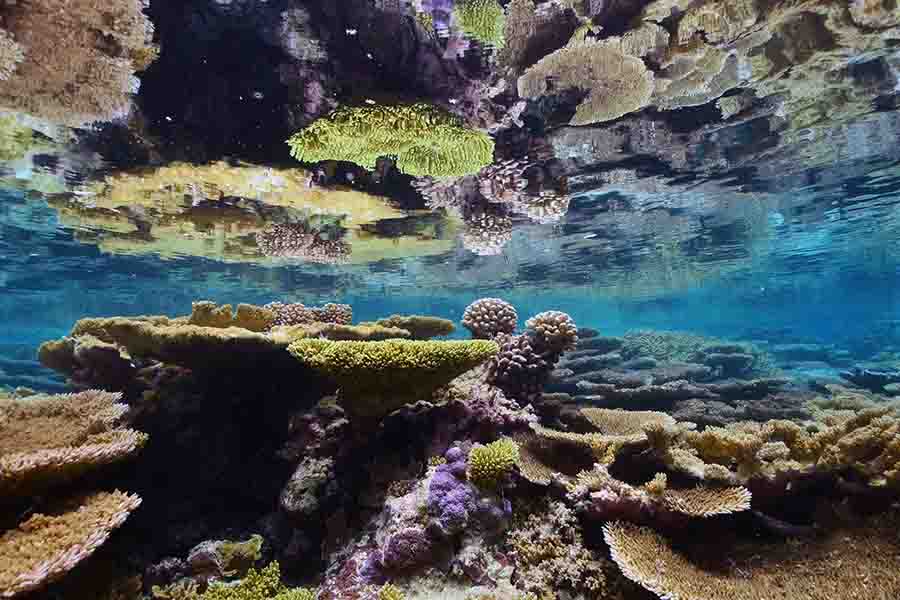
Coral reefs reflect in the shallow waters of the Palmyra Atoll National Wildlife Refuge, established in 2001 among a circular string of about 50 islets between Hawai‘i and American Samoa. (IMAGE: Kydd Pollock/The Nature Conservancy/Flickr)
Get Involved
EVERYONE can help protect coral reefs, and strong public support is one of the fastest ways to set change in motion, especially in the face of significant obstacles created by rapidly changing federal policy.
The more public support our coral reefs have, the more rapidly reef protections can be put in place and oceanic biodiversity can improve. That means increased food security, reduced erosion, and cleaner marine waters for all. Explore below to learn more!
- Policy
- Education
- Support
- Bills
- Engage Congress
- Vote
The following bills supporting open spaces have been introduced in congress. Read through each bill below to learn what it’s about and its current status, then continue on to the “Engage Congress” tab to discover how to easily request your congressperson’s support for these pieces of legislation. (When looking at the bill name and number, “H.R.” stands for House of Representatives and “S” stands for Senate.)
H.R.9705 – Oyster Reef Recovery Act
- Summary: Establishes the creation of the Oyster Reef Restoration and Conservation Program, which prioritizes oyster reef restoration, evaluates the health of existing reefs, and ensures the resilience of these reefs through various initiatives.
- Status: As of 9/19/24 – Referred to the House Committee on Natural Resources.
H.R.160 – Restoring Resilient Reefs Act of 2021
- Summary: Authorizes and revises the Coral Reef Conservation Program, provides grants to states working on coral reef restoration and preservation, strengthens federal actions to preserve these habitats, and implements coral reef emergency planning (among others).
- Status: As of 12/14/22 – Reported (Amended) by the Committee on Natural Resources and placed on the Union (House) Calendar.
H.R.950 – REEF Act | S.386 – REEF Act of 2023
- Summary: Directs the U.S. Navy to identify and report retiring vessels viable for the creation of artificial reefs.
- Status: As of 2/9/23 – Referred to the Committee on Armed Services (House and Senate).
H.R.7973 – South Florida Coral Reef Restoration Grant Program
- Summary: Directs the Secretary of Commerce to establish a grant program to support the restoration of coral reefs in South Florida.
- Status: As of 04/12/2024 – Referred to the House Committee on Natural Resources.
Not sure who represents you in congress? Follow these quick steps to find your congressional representatives and how to contact them:
- Click here and input your home address, then click the search icon.
- Under the name of the representative you want to reach, look for the section titled “Contact.”
- To make a phone call, copy the phone number provided.
- To send an email (or other form of outreach), select the blue hyperlinked word “contact.”
- This will take you to a page with different methods for reaching your representative.
Your vote means something. It’s your chance to voice your support for the people and policies you think will make a positive difference in your community and across the country.
Register to Vote
Not yet registered to vote? Get started:
It’s super easy! All you have to do is:
- Select the state or territory you live in
- Start your online voter registration
When registering, make sure you have a valid form of identification. This could be your Driver’s License, State ID, and/or Social Security Number.
Find Your Voting Location
Are you a new voter? Have you moved recently? Or maybe you just want to double check you know where you’re going? Find your voting location:
Remind Others to Vote
- Text election reminders to friends and family
- Snap that “I Voted” selfie and share it with the world (this simple act has been shown to increase voter turnout by 4.1%)
- Help others create a voting plan
- Sign up for programs like When We All Vote to help educate others on the importance of voting, important deadlines, and more
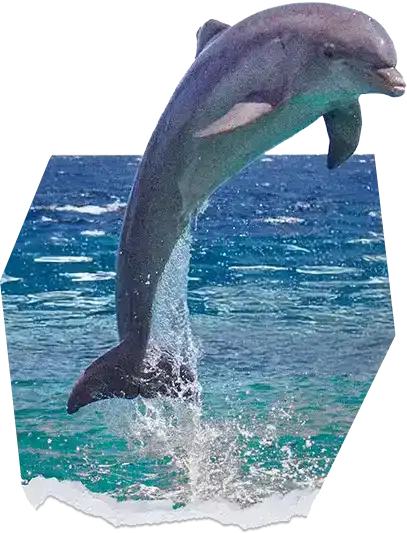
- The Issue
- Advocate
- Keep Learning
Though you may have never seen a coral reef in person, you likely already knew that these ecosystems are important and need to be protected. But did you know just how important they are? For example, did you know how coral reefs are tied to land protection and food security?
More education is needed to get people on board with widespread coral reef protections. This is the first step in building public support for coral reef restoration. Teaching children and adults how to identify the truths from the myths and establishing an understanding of what a healthy marine ecosystem looks like is critical if we want to build long-term, sustainable solutions to address coral reef restoration and protections.
Education also needs to be happening at the legislative level. Legislators—those with the power to make and pass laws—need to have a firm understanding of these basic concepts.
Share This Page
Help educate your network of friends, family and followers when you share this page and post about it on social media!
Explore Further
Interested in learning even more about the importance of coral reef restoration? We’ve compiled a list of key resources to help you move forward on your learning path.
Experts
Meet the professionals fighting for coral reef restoration throughout the U.S.
Learning Hubs
Dive deeper into the topic with more educational tools.
- Activity Packs for Kids | Coral Restoration Foundation
- Education Programs | National Aquarium
- Confronting Climate Change | Ocean Conservancy
Other Resources

- Nonprofit Limitations
- Donate
- Volunteer
Ask any nonprofit in America (and around the world) what their greatest two challenges are, and they are very likely to say the same things: funding and capacity.
Nonprofits striving to implement and advance coral reef restoration throughout the U.S. and around the globe are no stranger to this. That’s why your support—be it financial or through volunteer work—makes an enormous difference. By supporting an organization with your time and/or money, you are helping to increase their impact, expand their reach, and make it easier for good to be done for our planet.
Donate to Nonprofits
Meet the vetted EarthShare Nonprofit Partners making a difference for coral reef restoration and donate to their cause!
- Coral Restoration Foundation | Restoring reef sites throughout the Florida Keys using innovative methods to grow and outplant corals
- National Aquarium | Educating visitors on the critical nature of coral reefs and their impact on thousands of marine species
- National Fish and Wildlife Foundation | Promoting healthy coral ecosystems through threat reduction, coral restoration, and scientific testing
- Ocean Conservancy | Creating evidence-based solutions for a healthy ocean and the wildlife and communities that depend on it
- Oceana | Championing policy changes and victories that protect critical marine habitats around the world
- Oyster Recovery Partnership | Restoring oyster reefs in and around Chesapeake Bay, forging healthier marine habitats.
- Reef Relief | Teaching children, communities, and legislators about how to protect marine life and reef ecosystems
- SEE Turtles | Protecting hawksbill sea turtles and the coral reefs they call home through education and advocacy
- Sustainable Surf | Improving global marine ecosystems by planting seagrass, mangrove trees, kelp, and corals
- World Wildlife Fund | Safeguarding important coral reef systems and building resilient communities for a climate-ready future
Attend Events & Volunteer
Check out events and volunteer opportunities happening online, across the country, and near you.
- American Farmland Trust | Events | National
- Natural Land Institute | Events | Illinois
- One Earth | Events | National
- Savanna Institute | Events | Illinois
- Washington Farmland Trust | Events | Washington
- Zero FoodPrint | Events | National

- Policy
- Education
- Support
- Bills
- Engage Congress
- Vote
The following bills supporting open spaces have been introduced in congress. Read through each bill below to learn what it’s about and its current status, then continue on to the “Engage Congress” tab to discover how to easily request your congressperson’s support for these pieces of legislation. (When looking at the bill name and number, “H.R.” stands for House of Representatives and “S” stands for Senate.)
H.R.9705 – Oyster Reef Recovery Act
- Summary: Establishes the creation of the Oyster Reef Restoration and Conservation Program, which prioritizes oyster reef restoration, evaluates the health of existing reefs, and ensures the resilience of these reefs through various initiatives.
- Status: As of 9/19/24 – Referred to the House Committee on Natural Resources.
H.R.160 – Restoring Resilient Reefs Act of 2021
- Summary: Authorizes and revises the Coral Reef Conservation Program, provides grants to states working on coral reef restoration and preservation, strengthens federal actions to preserve these habitats, and implements coral reef emergency planning (among others).
- Status: As of 12/14/22 – Reported (Amended) by the Committee on Natural Resources and placed on the Union (House) Calendar.
H.R.950 – REEF Act | S.386 – REEF Act of 2023
- Summary: Directs the U.S. Navy to identify and report retiring vessels viable for the creation of artificial reefs.
- Status: As of 2/9/23 – Referred to the Committee on Armed Services (House and Senate).
H.R.7973 – South Florida Coral Reef Restoration Grant Program
- Summary: Directs the Secretary of Commerce to establish a grant program to support the restoration of coral reefs in South Florida.
- Status: As of 04/12/2024 – Referred to the House Committee on Natural Resources.
Not sure who represents you in congress? Follow these quick steps to find your congressional representatives and how to contact them:
- Click here and input your home address, then click the search icon.
- Under the name of the representative you want to reach, look for the section titled “Contact.”
- To make a phone call, copy the phone number provided.
- To send an email (or other form of outreach), select the blue hyperlinked word “contact.”
- This will take you to a page with different methods for reaching your representative.
Your vote means something. It’s your chance to voice your support for the people and policies you think will make a positive difference in your community and across the country.
Register to Vote
Not yet registered to vote? Get started:
It’s super easy! All you have to do is:
- Select the state or territory you live in
- Start your online voter registration
When registering, make sure you have a valid form of identification. This could be your Driver’s License, State ID, and/or Social Security Number.
Find Your Voting Location
Are you a new voter? Have you moved recently? Or maybe you just want to double check you know where you’re going? Find your voting location:
Remind Others to Vote
- Text election reminders to friends and family
- Snap that “I Voted” selfie and share it with the world (this simple act has been shown to increase voter turnout by 4.1%)
- Help others create a voting plan
- Sign up for programs like When We All Vote to help educate others on the importance of voting, important deadlines, and more

- The Issue
- Advocate
- Keep Learning
Though you may have never seen a coral reef in person, you likely already knew that these ecosystems are important and need to be protected. But did you know just how important they are? For example, did you know how coral reefs are tied to land protection and food security?
More education is needed to get people on board with widespread coral reef protections. This is the first step in building public support for coral reef restoration. Teaching children and adults how to identify the truths from the myths and establishing an understanding of what a healthy marine ecosystem looks like is critical if we want to build long-term, sustainable solutions to address coral reef restoration and protections.
Education also needs to be happening at the legislative level. Legislators—those with the power to make and pass laws—need to have a firm understanding of these basic concepts.
Share This Page
Help educate your network of friends, family and followers when you share this page and post about it on social media!
Explore Further
Interested in learning even more about the importance of coral reef restoration? We’ve compiled a list of key resources to help you move forward on your learning path.
Experts
Meet the professionals fighting for coral reef restoration throughout the U.S.
Learning Hubs
Dive deeper into the topic with more educational tools.
- Activity Packs for Kids | Coral Restoration Foundation
- Education Programs | National Aquarium
- Confronting Climate Change | Ocean Conservancy
Other Resources

- Nonprofit Limitations
- Donate
- Volunteer
Ask any nonprofit in America (and around the world) what their greatest two challenges are, and they are very likely to say the same things: funding and capacity.
Nonprofits striving to implement and advance coral reef restoration throughout the U.S. and around the globe are no stranger to this. That’s why your support—be it financial or through volunteer work—makes an enormous difference. By supporting an organization with your time and/or money, you are helping to increase their impact, expand their reach, and make it easier for good to be done for our planet.
Donate to Nonprofits
Meet the vetted EarthShare Nonprofit Partners making a difference for coral reef restoration and donate to their cause!
- Coral Restoration Foundation | Restoring reef sites throughout the Florida Keys using innovative methods to grow and outplant corals
- National Aquarium | Educating visitors on the critical nature of coral reefs and their impact on thousands of marine species
- National Fish and Wildlife Foundation | Promoting healthy coral ecosystems through threat reduction, coral restoration, and scientific testing
- Ocean Conservancy | Creating evidence-based solutions for a healthy ocean and the wildlife and communities that depend on it
- Oceana | Championing policy changes and victories that protect critical marine habitats around the world
- Oyster Recovery Partnership | Restoring oyster reefs in and around Chesapeake Bay, forging healthier marine habitats.
- Reef Relief | Teaching children, communities, and legislators about how to protect marine life and reef ecosystems
- SEE Turtles | Protecting hawksbill sea turtles and the coral reefs they call home through education and advocacy
- Sustainable Surf | Improving global marine ecosystems by planting seagrass, mangrove trees, kelp, and corals
- World Wildlife Fund | Safeguarding important coral reef systems and building resilient communities for a climate-ready future
Attend Events & Volunteer
Check out events and volunteer opportunities happening online, across the country, and near you.
- American Farmland Trust | Events | National
- Natural Land Institute | Events | Illinois
- One Earth | Events | National
- Savanna Institute | Events | Illinois
- Washington Farmland Trust | Events | Washington
- Zero FoodPrint | Events | National

Where to Start
We’ve curated a list of nonprofits doing coral reef work in the United States and around the world. Learn more about the incredible work they’re doing and show your support.
Check out these orgs!
Coral Restoration Foundation*Coral Reef Foundation is our 30×30 Partner for coral reef restoration and contributed their knowledge, experiences, and on-the-ground expertise to improve accuracy and storytelling. | Restoring reef sites throughout the Florida Keys using innovative methods to grow and outplant corals
National Aquarium | Educating visitors on the critical nature of coral reefs and their impact on thousands of marine species
National Fish and Wildlife Foundation | Promoting healthy coral ecosystems through threat reduction, coral restoration, and scientific testing
Ocean Conservancy | Creating evidence-based solutions for a healthy ocean and the wildlife and communities that depend on it
Oceana | Championing policy changes and victories that protect critical marine habitats around the world
Reef Relief | Teaching children, communities, and legislators about how to protect marine life and reef ecosystems
SEE Turtles | Protecting hawksbill sea turtles and the coral reefs they call home through education and advocacy
Sustainable Surf | Improving global marine ecosystems by planting seagrass, mangrove trees, kelp, and corals
World Wildlife Fund | Safeguarding important coral reef systems and building resilient communities for a climate-ready future
* EARTHSHARE 30×30 PARTNER
Created as part of the Mosaic 2023 Movement Infrastructure grant program
Share your thoughts on The 30×30 Project website
©2025 EarthShare. All rights reserved. EarthShare is a registered 501(c)(3) nonprofit.

